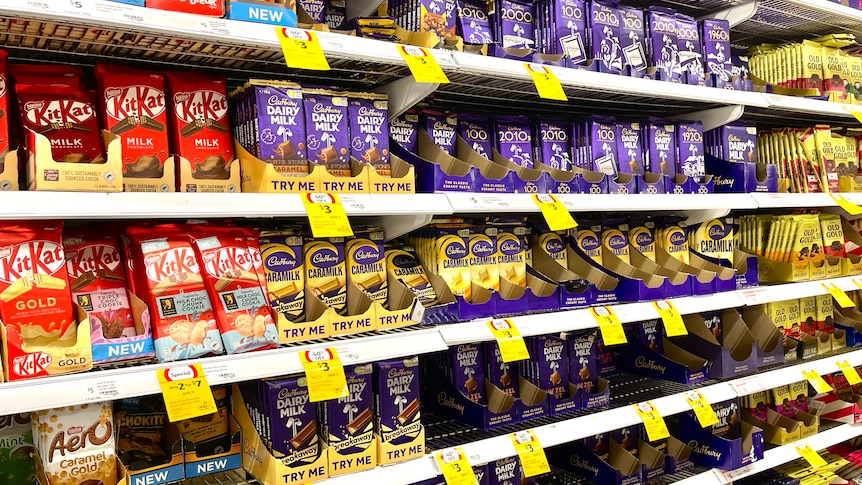When you stand in the confectionery isolate, how do you choose a block of chocolate? Is it decided by your taste buds? Or maybe your wallet?
Key points:
- The majority of Australia’s chocolate is sourced from the global cocoa commodity market
- One southern Queensland chocolate producer is breaking away from this traditional system
- Some chocolate makers want to offer full transparency and give credit to their source region’s cocoa farmers
The reality is that few of us consider the farm the cocoa was grown on.
If you do, your mind might reach for hazy images of western Africa’s Ivory Coast.
Yan Diczbalis, chief horticulturalist of the Queensland Department of Agriculture and Fisheries, says the region supplies more than half of the global cocoa commodity market.
It is a market that feeds the likes of Nestle, Hershey and Mondelez International, which produces the Cadbury brand.
But it is an old market, one long muddied by allegations of child labour, slavery and underpayment of the farmers who grow the beans.
“A lot of the pre-existing chocolate trading houses are out of Europe and have been around for 100, 200 years, which have grown out of this colonial commodity trade,” Dejan Borisavljevic, owner of Indonesian-based trading company Biji Kakao Trading, said.
“It’s an incredibly old trade route, and of course it’s had lots of issues with transparency.”
Almost all the chocolate on supermarket shelves is sourced in bulk from this commodity market — and when you are talking about the trade of over 4.5 million tonnes of cocoa, it can be difficult to trace a bean’s origin any further than the continent it was grown on .
For consumers, this makes it almost impossible to guarantee that any of your dollars make it to the farmer.
“I suppose [payments for cocoa are] beyond the remit of ours — all we know is we can’t influence the commodity market at all,” Mr Diczbalis said.
Cocoa farmers growing for the commodity market rely on corporate morality and schemes like Fairtrade to ensure growers are being justly paid for their product.
Mr Diczbalis says it is a system that lacks accountability.
A modern take on the historic cocoa trade
While container upon container of cocoa beans is unloaded onto the ports of Amsterdam and Hamburg another, albeit smaller, market is emerging.
Between the tall, corrugated iron sheds that line Toowoomba’s industrial area sits a small, unimposing building — one that you are likely to smell before you see.
That aroma comes from a factory owned by a pair of Swedish chocolatiers who make Australian chocolate using cocoa beans sourced from the Solomon Islands and Indonesia.
When Magda and Trevor Smith moved from Sweden to Australia, they wanted to continue their chocolate-making, but quickly realized that they would prefer a new trade route.
“Europe has an established cocoa industry, that spice trade has been going on for many hundreds of years,” Mr Smith, co-owner of Metiisto Chocolate, said.
“It makes sourcing cocoa [from Europe] really easy, but what it does is distance you from the actual farms.”
“You can’t check where your cocoa is coming from; you’ve got too many people in between you and the cocoa farmers.”
Instead of buying from the global commodity market, the Smiths buy their chocolate direct from Pacific farmers.
Those farmers include the likes of Robert Waisu, who has been growing cocoa in the Solomon Islands for the past 35 years.
An opportunity for Pacific cocoa growers
Mr Waisu sells his cocoa direct to “bean to bar” chocolatiers like the Smiths of Toowoomba.
“I’m selling my cocoa as premium cocoa that’s sun-dried at an attractive premium price,” Mr Waisu said.
“The domestic market pays us here 12 [Solomon Islands] dollars per kilogram of dry beans; they [the specialty buyers] pay us more like 50 per cent on top of this.”
He and other Solomon Islands cocoa farmers are proud of their cocoa’s quality, something he says the rest of the world is yet to recognize.
“Other people, globally, they don’t really know what’s going on here. But myself, I am really proud; we are really proud,” he said.
Chocolatiers like the Smiths are working to provide this recognition, labeling each of their bars with the name of the locality the cocoa was grown in.
Heather Smyth, a flavor chemist at the University of Queensland, describes it as something of an emerging market.
“For big companies in the likes of Cadbury, they’re really looking for a very consistent cocoa flavor that matches the flavor that they had before and the year before that and the year before that,” Dr Smyth said.
“SW [major corporations] will actually source cocoa from a whole lot of different regions to come up with a flavor profile which is recognizable to their customers.”
“But just as we recognize that wine and coffee have diverse flavor types, we need to recognize that with cocoa as well.”
“Within different regions there can be spicy notes, there’s often fruity notes that are present, even citrus notes, then of course your typical chocolate and coffee flavours.”
“It allows the community to receive payment for their specialty beans and for the quality of cocoa that they produce.”
legitimate transparency
While work is being done to reform the traditional cocoa trade system, Mr Diczbalis says that these emerging “bean to bar” trade routes are a good alternative for consumers looking for a transparent supply chain.
“All that sort of plantation cropping — for want of a better term — was sort of instigated during the colonial era,” Mr Diczbalis said.
“We can’t go back and change the way that it was. But what we can do is work with producers currently to improve their outlook.”
.
